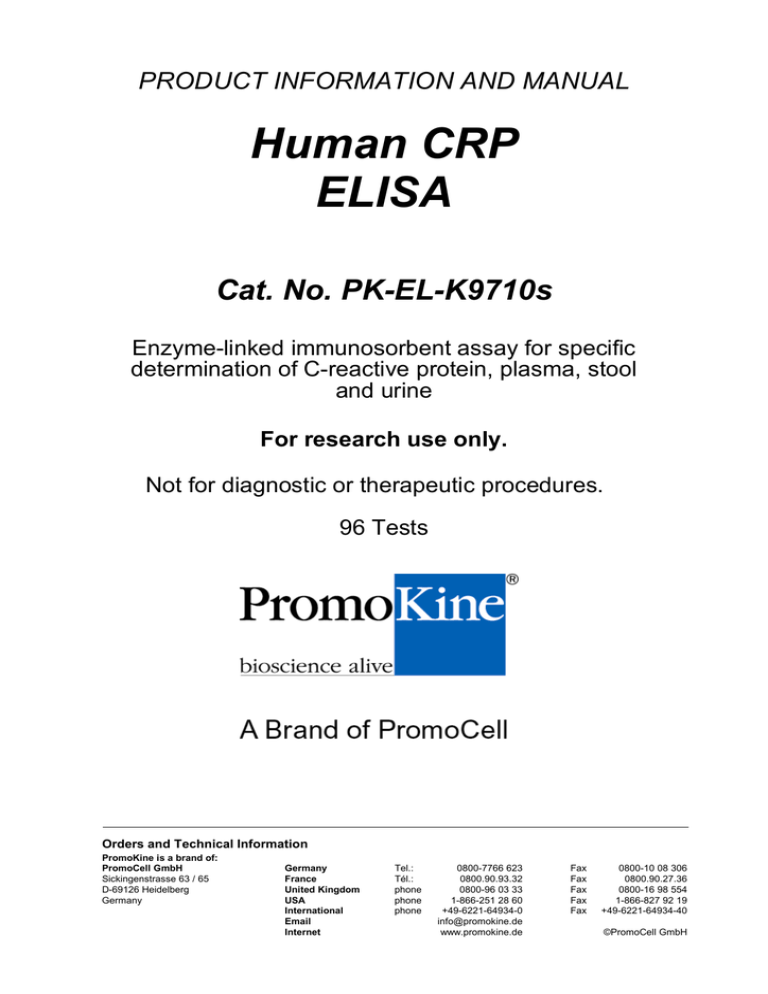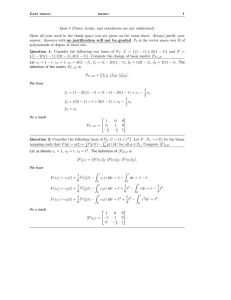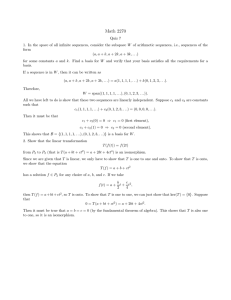PRODUCT INFORMATION AND MANUAL
advertisement

PRODUCT INFORMATION AND MANUAL Human CRP ELISA Cat. No. PK-EL-K9710s Enzyme-linked immunosorbent assay for specific determination of C-reactive protein, plasma, stool and urine For research use only. Not for diagnostic or therapeutic procedures. 96 Tests Orders and Technical Information PromoKine is a brand of: PromoCell GmbH Sickingenstrasse 63 / 65 D-69126 Heidelberg Germany Germany France United Kingdom USA International Email Internet Tel.: Tél.: phone phone phone 0800-7766 623 0800.90.93.32 0800-96 03 33 1-866-251 28 60 +49-6221-64934-0 info@promokine.de www.promokine.de Fax Fax Fax Fax Fax 0800-10 08 306 0800.90.27.36 0800-16 98 554 1-866-827 92 19 +49-6221-64934-40 ©PromoCell GmbH 1. INTENDED USE The PromoKine CRP ELISA is intended for the quantitative determination of C-reactive protein in plasma, serum stool and urine. It is for research use only. 2. SUMMARY AND EXPLANATION C-reactive Protein (CRP) is mainly formed in hepatocytes. The synthesis rate is determined by the influence of cytokines involved in inflammatory processes. The biological half-life is estimated to be 13-16 hours. A connection between inflammatory reactions and cardiovascular diseases such as arteriosclerosis and latent or chronically persisting infections has been described in recent studies. The CRP concentrations of healthy persons are under 5 μg/ml. As an acute phase protein, CRP is released within 24 hours after an inflammatory process has started (fever, pneumonia, myocardial infarction, etc.). CRP has been established as a marker for inflammation. Indications • Prognosis factor for myocardial infarction or stroke • Inflammatory processes 3. PRINCIPLE OF THE TEST This enzyme immuno assay is a sandwich assay for the determination of CRP in serum, plasma, urine and stool samples. The wells of the microtitre plate are coated with polyclonal antibodies directed against C-reactive Protein. In a first incubation step, the CRP in the samples is bound to the coated polyclonal rabbit antibodies (in excess). To remove all unbound substances, a washing step is carried out. In a second incubation step, a Peroxidase-labeled CRP (PO-Antibody, polyclonal, rabbit-anti-CRP) antibody is added. After another washing step, to remove all unbound substances, the solid phase is incubated with the substrate, Tetramethylbenzidine (TMB). An acidic stopping solution is then added. The color converts to yellow. The intensity of the yellow color is directly proportional to the concentration of CRP in the sample. A dose response curve of the absorbance (at 450 nm) unit vs. concentration is generated. CRP, present in the patient samples, is determined directly from this calibration curve. The combination of two specific antibodies in the CRP ELISA drastically reduces the possibility of false-negatives results and offers a secure diagnostic system to the user. PK-EL-K9710s 4. MATERIAL SUPPLIED The reagents of one kit are sufficient for 96 determinations. Each test kit contains: Kit Components Quantity one holder with precoated strips 96 ELISA wash buffer concentrate 10x 1 x 100 ml POD antibody, (rabbit-anti-CRP, Peroxidase-labeled), prediluted 1 x 150 μl Calibrators, ready to use (0; 1.9; 5.6; 16.7; 50; 150 ng/ml) 6 x 1 ml Control, ready-to-use 1 x 1 ml Dilution buffer, ready to use 2 x 100 ml TMB substrate (Tetramethylbenzidine), ready to use 1 x 15 ml ELISA stop solution, ready to use 1 x 7 ml The CRP calibrators were standardized against WHO standard 470. 5. MATERIAL REQUIRED BUT NOT SUPPLIED • Bi-distilled water (aqua bidest.) • Laboratory balance • Precision pipettors calibrated and tips to deliver 10-1000 μl • Covering foil for the microtiter plate • Horizontal microtiter plate shaker with 37°C incubator • A multi-channel dispenser or repeating dispenser • Centrifuge capable of 3000 x g • Vortex-Mixer • Standard laboratory glass or plastic vials, cups, etc. • Microtiter plate reader at 450 nm (reference wave length 620 or 690 nm) PK-EL-K9710s 6. PREPARATION AND STORAGE OF REAGENTS • To run assay more than once, ensure that reagents are stored at the conditions stated on the label. Prepare only the appropriate amount necessary for each assay. The kit can be used up to 4 times within the expiry date stated on the label. • Reagents with a volume less than 100 μl should be centrifuged before use to avoid loss of volume. • The ELISA wash buffer concentrate (WASHBUF) should be diluted with aqua bidest. 1:10 before use (50 ml concentrate + 450 ml aqua bidest.), mix well. Crystals could occur due to high salt concentration in the stock solutions. The crystals must be redissolved at room temperature or at 37°C using a water bath before dilution of the buffer solutions. The buffer concentrate is stable at 2-8°C until the expiry date stated on the label. Diluted buffer solution can be stored in a closed flask at 2-8°C for one month. • The POD-labeled antibody (AB) must be diluted 1:100 in wash buffer (WASHBUF) (100 μl AB + 10 ml WASHBUF). The antibody is stable at 2-8 °C until expiry date given on the label. Diluted antibody solution is not stable and could not be stored. • All other test reagents are ready to use. The test reagents are stable until the expiry date (see label of test package) when stored at 2-8°C. 7. PRECAUTIONS • Human materials used in kit components were tested and found to be negative for HIV, Hepatitis B and Hepatitis C. However, for safety reasons, all kit components should be treated as potentially infectious. • Stop solution is composed of sulfuric acid, which is a strong acid. Even diluted, it still must be handled with care. It can cause acid burns and should be handled with gloves, eye protection, and appropriate protective clothing. Any spills should be wiped out immediately with copious quantities of water. • Reagents should not be used beyond the expiration date shown on the kit label. 8. SPECIMEN COLLECTION AND PREPARATION Serum, plasma Collection and storage of serum: Collect sufficient blood (at least 1 ml) by venipuncture into a tube or a plastic syringe, avoid hemolysis, centrifuge for 15 minutes at 1,000 x g and 4°C and collect the serum. Collection and storage of plasma: Collect sufficient blood (at least 1 ml) by venipuncture into an EDTA venipuncture tube or a plastic syringe, centrifuge for 15 minutes at 1,000 x g and 4°C within 10 minutes after blood collection and separate the plasma from the cells. PK-EL-K9710s Serum and plasma samples have to be diluted 1:100 or 1:500 before performing the assay. Add 10 μl serum /plasma to 990 μl dilution buffer, mix well (1:100 dilution). Use the dilution factor (100 or 500) to calculate the CRP concentration read off the calibration curve. Patient’s samples with elevated CRP-concentrations must be diluted 1:4000 – 1:8000. Samples of other patient collectives must be diluted according to the expected CRPconcentration. The corresponding dilution factor must be used for calculation of the CRPconcentration. Faeces The test can be performed on either fresh or frozen stool samples. The samples should be refrigerated and can be stored at 2-8°C for 2 days. If the test cannot be performed within this period, the specimen should be stored at –20°C or colder. Add a stool sample of about 100 mg (size of a pea, please note the exact weight for the calculation) to 5 ml of the ELISA wash buffer and homogenize very thoroughly for 15 seconds on a Vortex-mixer. Centrifuge the suspension for 10 min at 3000 rpm. Pipet 1 ml of the supernatant into an Eppendorf tube and centrifuge at 13,000 rpm for 2 minutes. The supernatant can be stored at -20°C for about 1 month. 100 μl of this supernatant is used in the assay. We recommend for sample preparation the use of Roche Diagnostics / Mannheim sample preparation tubes, article No. 745804. Urine Urine samples must be diluted 1:5 with dilution buffer. 9. ASSAY PROCEDURE Procedural notes • Do not interchange different lot numbers of any kit component within the same assay. • Quality control guidelines should be observed. • Incubation time, incubation temperature and pipetting volumes of the components are defined by the producer. Any variation of the test procedure, which is not coordinated with the producer, may influence the results of the test. PromoCell can therefore not be held responsible for any damage resulting from wrong use. • The assay should always be performed according the enclosed manual. PK-EL-K9710s Test procedure Bring all reagents to room temperature and mix well before use. Wash the precoated microtiter strips 5 x with 250 μl ELISA wash buffer before use. Avoid direct sun light during all incubation steps. Covering the microtitre plate during the different incubation steps is recommended. Carrying out the tests in duplicate is also recommended. 1. Add 100 μl calibrator and samples and into each well. 2. Incubate for 1 hour shaking on a horizontal mixer at room temperature. 3. Aspirate and wash the wells 5 x with 250 μl ELISA wash buffer. 4. Add 100 μl prediluted Peroxidase-labeled CRP antibody. 5. Incubate for 1 hour shaking on a horizontal mixer at room temperature. 6. Decant the content of the plate and wash the wells 5 x with 250 μl ELISA wash buffer. 7. Add 100 μl TMB substrate solution into each well. 8. Incubate for 5 - 10 minutes at room temperature in the dark. 9. Add 50 μl stop solution into each well and mix shortly. 10. Measure the extinction of the samples at 450 nm directly after adding the stop solution. PK-EL-K9710s 10. RESULTS A calibration curve is constructed from the standards. Commercially available software can be used as well as graph paper. Results of the samples are read from this calibration curve. THE CALIBRATION CURVE IS NOT LINEAR, therefore a spline- or 4PL algorithm is recommended. Typical calibration curve Concentration [ng/ml] 150 OD mean value 1.901 50 16.7 5.6 1.9 0 1.813 1.258 0.622 0.256 0.045 The data is for demonstration only and cannot be used for the evaluation of test results. PK-EL-K9710s Faecal Example for calculation of the CRP concentration in faecal specimen: Weight: 80 mg (1ml stool = 1 g) = 0.08 ml Dilution step 1: 5 ml / 0,08 ml = 62.5 Dilution factor: 62.5 Multiply the results with the calculated dilution factor (in this case 62.5) to get the CRP concentration of the stool samples. Please note: the dilution factor depends on the weight of the used faecal specimen. Serum, plasma The value read from the calibration curve must be multiplied by 100 or 500 respectively to get the CRP concentration in serum/plasma samples. If samples were diluted 1:4000 or 1:8000, the estimated values must be multiplied by 4,000 or 8,000 respectively. Urine The measured CRP concentration must be multiplied by factor 5 to get the actual concentration of the samples. 11. LIMITATIONS Samples with CRP levels greater than the highest calibrator value should be diluted and re-assayed. 12. QUALITY CONTROL We recommend commercial control samples for internal quality control. Control samples should be analyzed with each run. Results, generated from the analysis of control samples, should be evaluated for acceptability using appropriate statistical methods. The results for the patient samples may not be valid, if within the same assay one or more values of the quality control sample are outside the acceptable limits. Expected values Normal ranges: CRP < 1 mg/l low CHD-Risk CRP 1-3 mg/l medium CHD-Risk CRP > 3 mg/l high CHD-Risk *(Person et al., 2003) PK-EL-K9710s If the CRP-concentration is found to be higher than 3 mg/l, a second determination should be made within 2 to 3 weeks. If the CRPconcentration is again high, and other reasons are excluded (acute infection, chronic-inflammatory diseases), the obtained CRPconcentration can be used for risk stratification in coronary heart disease (CHD) patients. If the CHD risk is high, the lifestyle should be changed together with medical treatment. These normal ranges should be used as a guideline only. It is recommended that each laboratory establishes an own expected range for its patient population. 13. PERFORMANCE CHARACTERISTICS Precision and reproducibility The precision (intra-assay variation) of the PromoKine CRP ELISA test was calculated from 20 replicate determinations on each one of two samples. Intra-Assay CV n= 20 Sample CRP mean value [ng/ml] Intra-Assay CV [%] 1 23.3 6 2 99.4 5.5 The total precision (inter-assay variation) of the PromoKine CRP ELISA test was calculated from data on 2 samples obtained in 15 different assays by three technicians on two different lots of reagents over a period of three months. Inter-Assay CV n= 15 Sample CRP Mean value [ng/ml] Inter-Assay CV [%] 1 22.1 11.6 2 90.4 13.8 Sensitivity n=20 Sample CRP Mean value [OD] Standard variation Detection limit [ng/ml] 1 0.053 0.007 0.124 PK-EL-K9710s Cross reactivity Alpha-1-Antitrypsin 0% Lysozym 0% Albumin 0% Other acute phase proteins 0% No cross reactivity with CRP in mouse serum was observed. 14. REFERENCES 1. Koenig W et al. (2004) Circulation 109: 1349-1353 2. Pearson TA et al. (2003) Circulation 107 : 645-651 3. Ridker P et al. (2000) N Engl J Med 342: 836-843 15. GENERAL NOTES ON THE TEST AND TEST PROCEDURE • This assay was produced and put on the market according to the IVD guidelines of 98/79/EC. • Human materials used in kit components were tested and found to be negative for HIV, Hepatitis B and Hepatitis C. However, for safety reasons, all kit components should be treated as potentially infectious. • Kit reagents contain sodium azide or thimerosal as bactericides. Sodium azide and thimerosal are toxic. Substrates for the enzymatic color reactions are toxic and carcinogenic. Avoid contact with skin or mucous membranes. • All reagents in the kit package are for research use only. • Reagents should not be used beyond the expiration date shown on the kit label. • Guidelines for medical laboratories should be observed. • Incubation time, incubation temperature and pipetting volumes of the components are defined by the producer. Any variation of the test procedure, which is not coordinated with the producer, may influence the results of the test. PromoCell can therefore not be held responsible for any damage resulting from wrong use. • Warranty claims and complaints in respect of deficiencies must be logged within 14 days after receipt of the product. The product shall be send to PromoCell along with a written complaint. PK-EL-K9710s 16. ORDERING INFORMATION For orders please contact: PromoCell GmbH Sickingenstrasse 63/65 D-69196 Heidelberg, Germany International Phone: +49-6221-64 93 40 International Fax: +49-6221-64 93 440 e-mail: info@promokine.de Deutschland: Telefon (gebührenfrei, Deutschland): 0800-776 66 23 Fax (gebührenfrei, Deutschland): 0800-100 83 06 France, Belgium, Luxembourg: Téléphone No. Vert: 0800-909332 (français) Télécopie No. Vert: 0800-902736 UK, Ireland: Free Phone: 0800-96 03 33 (english) Free Fax: 0800-169 85 54 USA, Canada: Toll free: 1-866-251 28 60 (english) Free Fax: 1-866-827 92 19 www.promokine.info Cat.No. PK-EL-K9510s human CRP ELISA For technical information please contact: info@promokine.info PK-EL-K9710s



